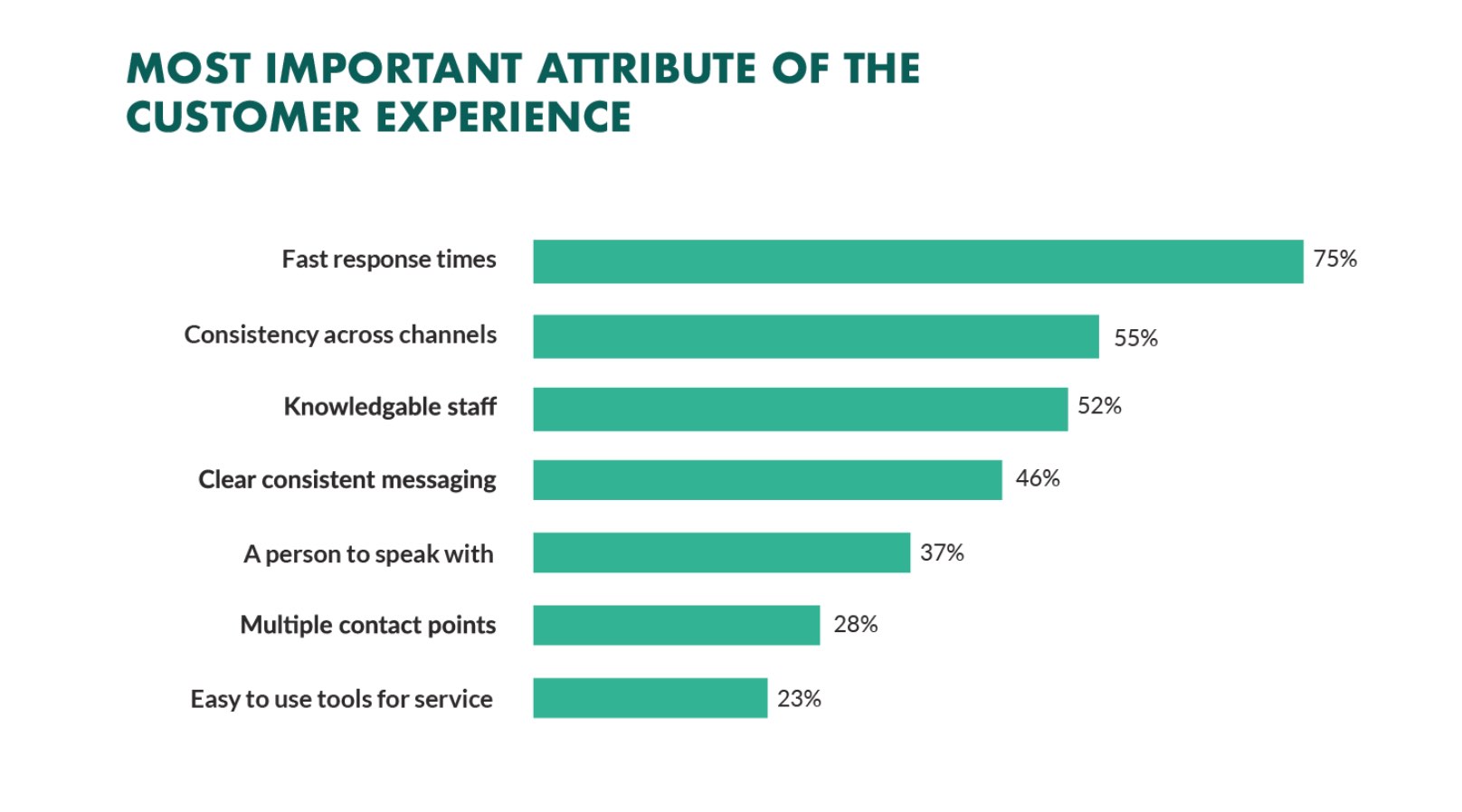Customer service is no longer just about solving problems.
It’s how today’s best brands drive loyalty, revenue…and love.
The proof? Companies that lead in customer experience outperform laggards by nearly 80% in revenue growth. And 86% of consumers say a single great service interaction can turn them into loyal advocates.
Meanwhile, the stakes are rising.
In a world of instant reviews and endless options, even one slip can cost you a customer - and their entire network.
- 1 in 3 customers will leave a brand they love after one bad experience.
- 60% will share that bad experience with others - instantly.
In other words: great service is no longer a nice-to-have. It’s your competitive edge.
How Top Brands Are Raising the Bar
Top brands are rewriting the playbook.
They’re blending empathy with automation - delivering support that feels human and instant. And they’re empowering reps with real-time context. And they’re delivering service so good, it feels like magic - across every channel.
In this article, we’ll explore:
- What customers expect today
- How standout brands are delivering (with 5 real stories)
- And how you can turn your service team into your strongest growth asset
Let’s dive in.
What Is Great Customer Service Today?
It’s not just about being nice.
It’s about being relevant, responsive, and reliable - at scale.
Great customer service today means showing up with the right answer, at the right time, on the right channel - without making your customers repeat themselves.
It’s proactive, not reactive. Personalized, not templated.
And it’s measurable:
- Brands with excellent service see 3.5x more revenue growth
- 95% of customers say experience is as important as price
- 76% of consumers expect agents to know their history (but 50% say they rarely do)
What separates good from great? Context, consistency, and culture.
The best companies build around the customer - not the case number.
They use tools that give agents full visibility, and empower teams to fix problems before they escalate.
The result? Loyalty, word-of-mouth, and a support team that actually drives growth.
What Customers Demand in 2025
In 2025, “good enough” isn’t good enough.
Today’s customers expect service that’s fast, effortless, and deeply personal - delivered exactly when and where they need it. Here’s what that looks like now:
1. Zero Repetition
76% of customers expect agents to know who they are and what they’ve been through. But half still have to repeat themselves - and nothing kills momentum faster. With full context, reps move faster - and avoid the #1 frustration: repeating information.
2. Omnichannel Fluidity
Your customers don’t think in channels. They think in experiences. They might DM on Monday, email on Tuesday, and call on Friday - and expect every touchpoint to connect like one ongoing conversation. The best teams make that seamless: same tone, same context, no friction.
3. Real-Time Support
Speed isn’t a nice-to-have. It’s non-negotiable.
Think under 60 seconds for chat. Under 1 hour for email. Even for complex issues, slow is the new broken. 82% of customers say faster service makes them more loyal - and they mean it.

4. Empathy That Scales
The “how” matters as much as the “what.” Empathy turns a solved ticket into a memorable experience. From Chewy’s hand-written condolences to Delta’s human-first resolutions, the best brands bake empathy into every reply - even as they scale.
5. Proactive Problem-Solving
The best support is about always being one step ahead. That means flagging issues before they escalate, sharing updates without being asked, and reaching out before frustration kicks in. It shows customers you’re not just there to fix things - you’re there to protect the experience.
Bottom line?
Customers expect smart, connected, human service - no matter how big your team is.
Customers expect fast, personal, proactive support - every time. SuperOffice Service gives your team the tools to meet (and exceed) those expectations at scale. See how it works.
5 Modern Customer Service Stories That Set the Standard
Customer service isn’t a cost - it’s your brand in real time.
In a world where products are easy to copy, service is your sharpest edge. The best brands don’t just “handle support” - they turn it into a loyalty engine.
Here are five standout stories that prove customer service isn’t a cost center - it’s your brand in action.
1. Chewy: Empathy That Creates Loyalty
When a customer contacted Chewy to cancel their auto-ship order after losing their dog, the rep didn’t just close the ticket. They sent flowers. And a handwritten condolence note.
This wasn’t a policy - it was a human decision made by a pet-loving team empowered to care. In a world of scripted replies, moments like these turn customers into lifelong fans.
2. Comcast: Smarter, Faster Support with AI
Assist Comcast gave agents a generative AI tool called “Ask Me Anything,” trained on real-time account data, policies, and help content. Agents now resolve cases 10% faster - with less stress and more confidence.
The AI doesn’t replace reps - it equips them to serve better, faster, and with fewer escalations. Support becomes a conversation, not a knowledge chase.
3. Wendy’s: Social Support That Actually Shows Up
Wendy’s doesn’t just monitor social - they run it like a conversation. Questions, complaints, random tweets? Their support team replies fast - with humour, clarity, and real help.
Their playful tone builds goodwill, but their speed builds trust. In a public arena, service isn’t just support - it’s brand marketing in motion.
4. Spotify: Solving Problems Before They Start
Spotify’s support team monitors user behaviour to catch bugs before they go viral. When a sync issue triggered spikes in skipped songs, they patched it fast - and proactively message affected users - and social media followers - before tickets even came in.
It’s a shift from reactive to predictive support - and users notice. Instead of frustration, customers feel taken care of before they even know there’s a problem.
5. Delta: Turning Disruption Into Loyalty
When snow grounded flights in NYC, Delta didn’t just send apology emails. They texted meal vouchers in real time, followed up with 10,000 SkyMiles, and added a personal note.
This is how you turn inconvenience into advocacy - by responding fast and adding value. Delta showed that great service isn’t just about what you fix - it’s how you make people feel along the way.
These brands are setting the standard - and you can too. With SuperOffice, you can automate where it makes sense, personalize where it matters, and deliver service so good it becomes part of your brand.
See SuperOffice Service in action.
How to Deliver Service That Scales (Without Losing the Human Touch)
Today’s customers want it all: fast responses, real empathy, and zero repetition. But as teams grow and channels multiply, delivering high-quality service at scale gets harder - unless you have the right systems in place.
Here’s how modern teams are meeting high expectations without burning out support agents:
1. Centralize Customer Context
Reps shouldn’t have to dig for data. When you unify conversations, purchases, and history in one view, agents get instant clarity - and customers get seamless experiences.
When reps see the full story upfront, they deliver faster, more personalized support - and avoid the #1 frustration: repetition. A single, shared view doesn’t just help agents - it makes the customer feel known, respected, and valued.
Pro tip: Use a CRM to pull contact history, product usage, and prior conversations into one screen - so reps never ask twice.
With SuperOffice CRM, you can pull contact history, product usage, and prior conversations into one screen - so reps never ask twice. Book a 30-minute demo and see how unified context creates faster, more personal support.

2. Automate the Right Moments
Customers want fast answers, but they don’t want robotic ones. The key? Automate repeatable questions (like password resets) and route more complex issues to humans.
And it works: Companies that blend automation with human support reduce resolution time by 30% and improve satisfaction by 21%.
Automation should feel invisible - helpful when needed, human when it matters. Get it right, and you’ll boost both speed and satisfaction without sacrificing your brand’s personality.
Pro tip: Use smart routing to auto-direct tickets based on topic, customer value, or urgency - and escalate when empathy is required.
3. Create Feedback Loops That Drive Change
Every support interaction is a chance to learn. High-performing teams track themes, tag common issues, and share insights across product, marketing, and leadership teams.
The result? Fewer complaints, better products, and faster updates - all powered by real customer voices. It turns support from reactive firefighting into a strategic growth engine.
When systems work behind the scenes, your agents can focus on what matters most: helping people.
Pro tip: Set up tags and categories in your CRM to spot recurring issues - and trigger proactive fixes.
Turn Service Into Your Competitive Edge
Customer service isn’t just a cost center - it’s a growth engine. In fact, more than half of customers say service is the #1 factor in whether they stay loyal to a brand.
And in 2025, the stakes are higher than ever:
- 96% of consumers say service influences loyalty
- 1 in 3 are willing to pay more for exceptional support
- 88% say good service makes them more likely to recommend a brand
The takeaway?
Service isn’t optional - it’s a differentiator.
And the brands that invest in it win.
With SuperOffice, you can scale support, speed up resolutions, and personalize every interaction - without losing the human touch.
- Connect every channel into one inbox
- Surface full customer context instantly
- Automate intelligently (not impersonally)
- Turn every ticket into a growth opportunity
You’re already talking to customers. Now’s the time to turn those conversations into growth.
Book a 30-minute demo and see how SuperOffice can help you deliver standout service at scale.




